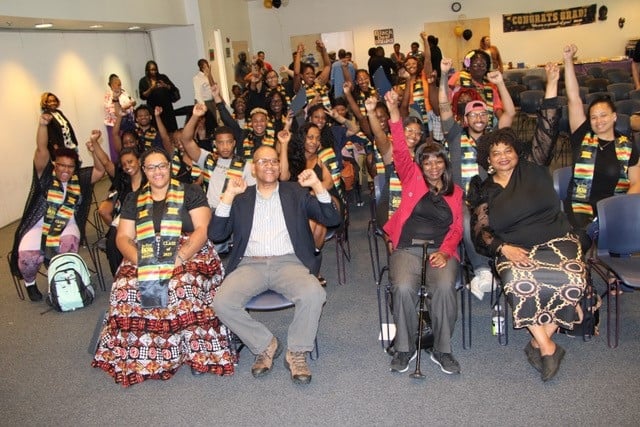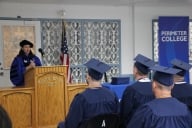You have /5 articles left.
Sign up for a free account or log in.

The Center for Black Deaf Studies at Gallaudet University is expected to receive a new infusion of funds after a fundraising campaign launched by university leaders.
Ruth Reed
J.C. Smith, a senior at Gallaudet University, grew up using Black American Sign Language, a variation of ASL used by African Americans, with some of his high school classmates at Mississippi School for the Deaf. But when he got to Gallaudet, a private university dedicated to Deaf and hard-of-hearing students in Washington D.C., he felt like he had to “code-switch.”
“We used our own slang, our own language. We had our own culture there,” Smith said of his upbringing in Jackson, Miss. But he felt like Black ASL “was looked at like kind of a ‘hood’ language” or “inappropriate” at the university, he said. He started using it less and less.
Then Gallaudet opened its Center for Black Deaf Studies in 2020, his sophomore year, and Smith started working at the center as a student support specialist. The center, launched in the aftermath of George Floyd’s murder by police, runs courses and events on Black Deaf history and culture. It also serves as a gathering place for Black students. Last year the center began offering a minor in Black Deaf studies.
“I felt like my BASL roots started to emerge again,” Smith said. Students would gather to eat culturally significant food, talk about shared experiences and learn about Black Deaf histories they hadn’t previously been taught. He said it felt like the closest thing to having an “HBCU experience” at Gallaudet, a predominantly white institution.
Gallaudet is now putting new resources into supports for its Black community and acknowledging racial injustices from the past. The university is in the midst of a new campaign, called the Necessity of Now, to raise $23 million for the center and for a memorial dedicated to Louise B. Miller, who famously sued the D.C. Board of Education in 1952 on behalf of her Black Deaf son and other Black students who were denied admission to the K-12 Kendall School for the Deaf, located on Gallaudet’s campus. (A separate K-12 school for Black children, the Kendall School Division II for Negroes, was created in the aftermath and existed on campus from 1952 to 1954 until segregation became illegal.) The university previously commemorated Miller with a small plaque, a sore point for Black students who wanted to see her legacy more prominently acknowledged.
The university plans to allocate $10 million to the center to expand scholarships, research and programming, and $13 million to build the memorial, called the Louise B. Miller Pathways and Gardens: A Legacy to Black Deaf Children. The memorial will feature panels that explain Miller’s story along a winding, flower-lined path; a shallow pool of water where the segregated school once stood; and sculptures of Miller and her son. The university has raised $8 million so far.
Gallaudet president Roberta Cordano explained the driving force behind the campaign: “Our students demanded it,” she said. “Our students brought it to our attention. They said there was an old, untold story.”
She hopes its impact reaches far beyond the university.
“Our goal is not only to have this commitment and awareness-building happening for our Gallaudet community, but also for our neighbors … in the nation’s capital and for people who come to visit from all over the world to learn about this important history,” Cordano said.
The institution has undertaken other initiatives in recent years to bolster diversity, equity and inclusion work and reckon with its past. Gallaudet leaders suspended a fraternity in 2020 for planning to bring back hooded ceremonial robes reminiscent of those the KKK wore. Last summer, the university held a long-delayed graduation ceremony for 24 Black Deaf students who attended the segregated Kendall School but were denied high school diplomas. Gallaudet also announced a new Center for Latine Deaf Studies the following month.
Cordano said the campaign is part of these larger efforts.
“There is beauty and pain in acknowledging past injustices,” she said. “Bringing justice to the table through an experience such as this assists all of us in healing.”
An ‘Absolute Must’
Gallaudet currently enrolls 169 Black Deaf students, nearly 17 percent of the 1,023 Deaf undergraduate and graduate students at the university. (The full student body, 1,316 students, includes hearing students as well.)
Most Black Deaf undergraduates, 77 percent, receive Pell Grants, federal financial aid for low-income students, according to data from the university. Their retention rate, 83 percent, is slightly below the 85 percent retention of their white Deaf peers.
Evon Black, co-director of the Center for Black Deaf Studies and a Gallaudet alumna, said those students need more financial and academic supports than they currently have available, particularly Black Deaf men, who graduate at lower rates than women. The university currently offers several different scholarship programs and an academic support program called ALLSTAR, which includes mentoring and tutoring services. But Black would like to see those kinds of offerings grow. (This paragraph was revised to clarify that the university, not the center, runs the scholarship and support programs.)
She also wants to see Gallaudet train, hire and retain more Black faculty members; she never learned Black Deaf history growing up, she said, and only had one Black and Deaf instructor at Gallaudet—and not until graduate school.
“We need instructors who look like them,” she said. “That’s what’s really needed. It’s 2023.”
Smith, the student, said interacting with Black Deaf Ph.D.s and doctors at the center has been eye-opening.
“It really motivated me,” he said. “I realized that, look, I need my degree. I need higher education to move up, to get to where they are.”
Tia Ivanko, co-director of the National Deaf Center on Postsecondary Outcomes at the University of Texas at Austin, wrote in an email that, in general, “Black deaf students are significantly underrepresented in postsecondary education.” She noted that the National Postsecondary Student Aid Study found that Black students make up 10 percent of the Deaf college population, compared to 13 percent of hearing students.
Data from the Texas center also show that 15.6 percent of Black Deaf people hold a bachelor’s degree or higher, compared to 23.8 percent of white Deaf people.
Black Deaf students confront all kinds of additional barriers at higher ed institutions, including “microaggressions” on and off campus, class materials “that fail to validate their unique cultural practices and identity, culturally insensitive interpreters, and negative attitudes and biases from faculty and staff,” Ivanko said. “Stigma and cultural barriers” can also prevent such students from seeking out accommodations and services, “which can have devastating consequences both inside and outside of the classroom.”
“This is just the tip of the iceberg,” she said. “At the end of the day, there is an urgent need for targeted research and systemic changes to dismantle the intersecting oppressions faced by Black deaf individuals in educational and professional settings.”
Lindsay Dunn, co-director of the Center for Black Deaf Studies and also a Gallaudet alumnus, said there are too few Black Ph.D.s, let alone Black Deaf Ph.D.s, which contributes to the lack of professors familiar with Black ASL and Black Deaf history and culture.
“We see Black students using Black ASL on campus, in the dorms and in their social hours,” Dunn said. “But we need to see that in the classroom as well.”
He believes part of the center’s draw is that it’s a rare academic setting where students feel like they can communicate the way they want.
At the center, “we are finding a space where we can really chat, chill, hang out, get down … just be ourselves, just for a minute,” Dunn said.
He emphasized that Black Deaf history stretches back “centuries,” with Africans using sign language as early as 960 A.D., and that there are 54 Indigenous African sign languages. Black ASL’s roots go back to the era of enslavement, when Black Deaf people developed their own language without significant exposure to white Deaf people or ASL, he noted.
“Most people have no clue about that, including the Deaf community at large,” Dunn said. But he expressed confidence that “with time, this knowledge will grow and will spread to the larger communities [who will] recognize that, indeed, Black Deaf people are part of America’s excellence and diversity.”
Staff members and students at the center believe they’re at the forefront of that fight. Black said one of her goals for the new funds raised is to create a curriculum for Deaf K-12 schools that teaches the story of Louise B. Miller so that children can start to learn Black Deaf history earlier.
Smith described the campaign as an “absolute must” to honor Miller and ensure the center’s longevity. His work has made him think about what it means to be a role model for future Black Deaf students, he said. During his time in college, he produced a video of Martin Luther King Jr.’s “I Have a Dream” speech in Black ASL, which garnered tens of thousands of views, and he was featured as a Black ASL advocate at the 2022 BET Awards.
“How can I make an impact for the next generation of people who might look up to me,” he said, “and make an impact for those people who … might have a similar experience in terms of being in my shoes?”









